‘Ultrasound Examination’ of the Musculoskeletal System: Bibliometric/Visualized Analyses on the Terminology (Change)
Abstract
1. Introduction
2. Materials and Methods
Analysis of Results
3. Results
3.1. Annual Distribution of Publications
3.2. Countries or Regions
3.3. Journals
3.4. Co-Occurrence Analysis
4. Discussion
5. Conclusions
Author Contributions
Funding
Institutional Review Board Statement
Informed Consent Statement
Data Availability Statement
Acknowledgments
Conflicts of Interest
References
- De Muynck, M.; Parlevliet, T.; De Cock, K.; Vanden Bossche, L.; Vanderstraeten, G.; Özçakar, L. Musculoskeletal ultrasound for interventional physiatry. Eur. J. Phys. Rehabil. Med. 2012, 48, 675–687. [Google Scholar] [PubMed]
- Özçakar, L.; Çarlı, A.B.; Tok, F.; Tekin, L.; Akkaya, N.; Kara, M. The utility of musculoskeletal ultrasound in rehabilitation settings. Am. J. Phys. Med. Rehabil. 2013, 92, 805–817. [Google Scholar] [CrossRef] [PubMed]
- Kim, T.K.; Lee, J.H.; Park, K.D.; Lee, S.C.; Ahn, J.; Park, Y. Ultrasound versus palpation guidance for intra-articular injections in patientswith degenerative osteoarthritis of the elbow. J. Clin. Ultrasound. 2013, 41, 479–485. [Google Scholar] [CrossRef]
- Özçakar, L.; Ricci, V.; Mezian, K.; Pirri, C. A New and Dedicated Video Gallery: EURO-MUSCULUS/USPRM Protocols for Dynamic Ultrasound Examination of the Joints. Am. J. Phys. Med. Rehabil. 2022, 101, 201–202. [Google Scholar] [CrossRef] [PubMed]
- Foti, C.; Ozçakar, L.; Kara, M.; Mahmoud, A.; Sallì, M.; Ciocchetti, E.; Pitruzzella, M.; Franchignoni, F. Changing the awareness of physiatrists on musculoskeletal ultrasound: Italy in EURO-MUSCULUS. Int. J. Rehabil. Res. 2013, 36, 178–181. [Google Scholar] [CrossRef]
- Özçakar, L.; Malas, F.U.; Kara, G.; Kaymak, B.; Hascelik, Z. Musculoskeletal sonography use in physiatry: A single-center one-year analysis. Am. J. Phys. Med. Rehabil. 2010, 89, 385–389. [Google Scholar] [CrossRef]
- Mezian, K.; Ricci, V.; Güvener, O.; Jačisko, J.; Novotný, T.; Kara, M.; Chang, K.V.; Naňka, O.; Pirri, C.; Stecco, C.; et al. EURO-MUSCULUS/USPRM Dynamic Ultrasound Protocols for (Adult) Hip. Am. J. Phys. Med. Rehabil. 2022, 101, e162–e168. [Google Scholar] [CrossRef]
- Jacobson, J.A.; Ruangchaijatuporn, T.; Khoury, V.; Magerkurth, O. Ultrasound of the Knee: Common Pathology Excluding Extensor Mechanism. Semin. Musculoskelet. Radiol. 2017, 21, 102–112. [Google Scholar]
- Ricci, V.; Özçakar, L. From “Ultrasound Imaging” to “Ultrasound Examination”: A Needful Upgrade in Musculoskeletal Medicine. Pain Med. 2020, 21, 1304–1306. [Google Scholar] [CrossRef]
- Pirri, C.; Stecco, C.; Pirri, N.; De Caro, R.; Özçakar, L. Ultrasound examination avoids tunnel vision: Diagnosing a simple/painful (epi)dermal cyst. Med. Ultrason. 2022, 24, 377–378. [Google Scholar] [CrossRef]
- Pirri, C.; Stecco, A.; Fede, C.; De Caro, R.; Stecco, C.; Özçakar, L. Ultrasound imaging of a scar on the knee: Sonopalpation for fascia and subcutaneous tissues. Eur. J. Transl. Myol. 2020, 30, 8909. [Google Scholar] [CrossRef] [PubMed]
- Meng, S.; Platzgummer, H.; Loizides, A.; Chang, K.V.; Gruber, H. Ultrasound of Small Nerves. Ultraschall. Med. 2022, 43, 12–33. [Google Scholar] [CrossRef] [PubMed]
- Özçakar, L.; Ata, A.M.; Kaymak, B.; Evans, S.; Kara, M. One Step Further in “Sono-Palpation” During Ultrasound Imaging: “Self-Palpation”. Pain Med. 2018, 19, 411. [Google Scholar] [CrossRef] [PubMed]
- Woods, R.; Wisniewski, S.J.; Lueders, D.R.; Pittelkow, T.P.; Larson, D.R.; Finnoff, J.T. Can ultrasound be used to improve the palpation skills of physicians in training? A prospective study. PM R 2018, 10, 730–737. [Google Scholar] [CrossRef]
- Hou, D.; Bi, X.; Mao, Z.; Fan, Y.; Hu, X.; Li, X. Biomaterials research of China from 2013 to 2017 based on bibliometrics and visualization analysis. PeerJ 2019, 7, e6859. [Google Scholar] [CrossRef]
- Mao, X.; Chen, C.; Wang, B.; Hou, J.; Xiang, C. A global bibliometric and visualized analysis in the status and trends of subchondral bone research. Medicine 2020, 99, e20406. [Google Scholar] [CrossRef]
- Zhang, Y.; Zhang, T.; Liu, X.; Zhang, L.; Hong, F.; Lu, M. Research trends of pregnancy with scarred uterus after cesarean: A bibliometric analysis from 1999 to 2018. J. MaternFetal Neonatal Med. 2020, 35, 3555–3564. [Google Scholar] [CrossRef]
- Pei, W.; Peng, R.; Gu, Y.; Zhou, X.; Ruan, J. Research trends of acupuncture therapy on insomnia in two decades (from 1999 to 2018):a bibliometric analysis. BMC Complement. Altern. Med. 2019, 19, 225. [Google Scholar] [CrossRef]
- Wu, W.T.; Lin, C.Y.; Shu, Y.C.; Chen, L.R.; Özçakar, L.; Chang, K.V. Subacromial Motion Metrics in Painful Shoulder Impingement: A Dynamic Quantitative Ultrasonography Analysis. Arch. Phys. Med. Rehabil. 2022, 104, 260–269. [Google Scholar] [CrossRef]
- Lin, J.; Fessell, D.P.; Jacobson, J.A.; Weadock, W.J.; Hayes, C.W. An illustrated tutorial of musculoskeletal sonography: Part I, introduction and general principles. AJR Am. J. Roentgenol. 2000, 175, 637–645. [Google Scholar] [CrossRef]
- So, S.; Patel, R.M.; Orebaugh, S.L. Ultrasound imaging in medical student education: Impact on learning anatomy and physical diagnosis. Anat. Sci. Educ. 2017, 10, 176–189. [Google Scholar] [CrossRef]
- Qiu, Y.; Yang, W.; Wang, Q.; Yan, S.; Li, B.; Zhai, X. Osteoporosis in postmenopausal women in this decade: A bibliometric assessment of current research and future hotspots. Arch. Osteoporos. 2018, 13, 121. [Google Scholar] [CrossRef]
- Yablon, C.M.; Jacobson, J.A. Rotator cuff and subacromial pathology. Semin. Musculoskelet. Radiol. 2015, 19, 231–242. [Google Scholar] [PubMed]
- Ricci, V.; Güvener, O.; Chang, K.V.; Wu, W.T.; Mezian, K.; Kara, M.; Leblebicioğlu, G.; Pirri, C.; Ata, A.M.; Dughbaj, M.; et al. EURO-MUSCULUS/USPRM Dynamic Ultrasound Protocols for Elbow. Am. J. Phys. Med. Rehabil. 2022, 101, e83–e92. [Google Scholar] [CrossRef] [PubMed]
- Mezian, K.; Ricci, V.; Güvener, O.; Jačisko, J.; Novotny, T.; Kara, M.; Ata, A.M.; Wu, W.T.; Chang, K.V.; Stecco, C.; et al. EURO-MUSCULUS/USPRM Dynamic Ultrasound Protocols for Wrist and Hand. Am. J. Phys. Med. Rehabil. 2022, 101, e132–e138. [Google Scholar] [CrossRef] [PubMed]
- Macchi, V.; Stocco, E.; Stecco, C.; Belluzzi, E.; Favero, M.; Porzionato, A.; De Caro, R. The infrapatellar fat pad and the synovial membrane: An anatomo-functional unit. J. Anat. 2018, 233, 146–154. [Google Scholar] [CrossRef] [PubMed]
- Poboży, T.; Konarski, W.; Piotrowska-Lis, K.; Domańska, J.; Poboży, K.; Kielar, M. Basic Differences and Most Common Findings in Ultrasound Examinations of Musculoskeletal System in Children: A Narrative Literature Review. Healthcare 2022, 10, 2010. [Google Scholar] [CrossRef]
- Özçakar, L.; Kara, M.; Quittan, M.; Ata, A.M.; Michail, X.; Kaymak, B. The need for an integrative musculoskeletal approach in sarcopenia: The ISarcoPRM Kickstart. Eur. J. Phys. Rehabil. Med. 2020, 56, 535–536. [Google Scholar] [CrossRef]
- Can, B.; Kara, M.; Kara, Ö.; Ülger, Z.; Frontera, W.R.; Özçakar, L. The value of musculoskeletal ultrasound in geriatric care and rehabilitation. Int. J. Rehabil. Res. 2017, 40, 285–296. [Google Scholar] [CrossRef] [PubMed]
- Kara, M.; Gürçay, E.; Ekiz, T.; Sekizkardeş, M.; Yorulmaz, E.; Ata, A.M.; Chang, K.V.; Wu, W.T.; Akkaya, N.; Mezian, K.; et al. EURO-MUSCULUS/USPRM Global Report on Musculoskeletal Ultrasound Publications. Am. J. Phys. Med. Rehabil. 2020, 99, 847–852. [Google Scholar] [CrossRef]
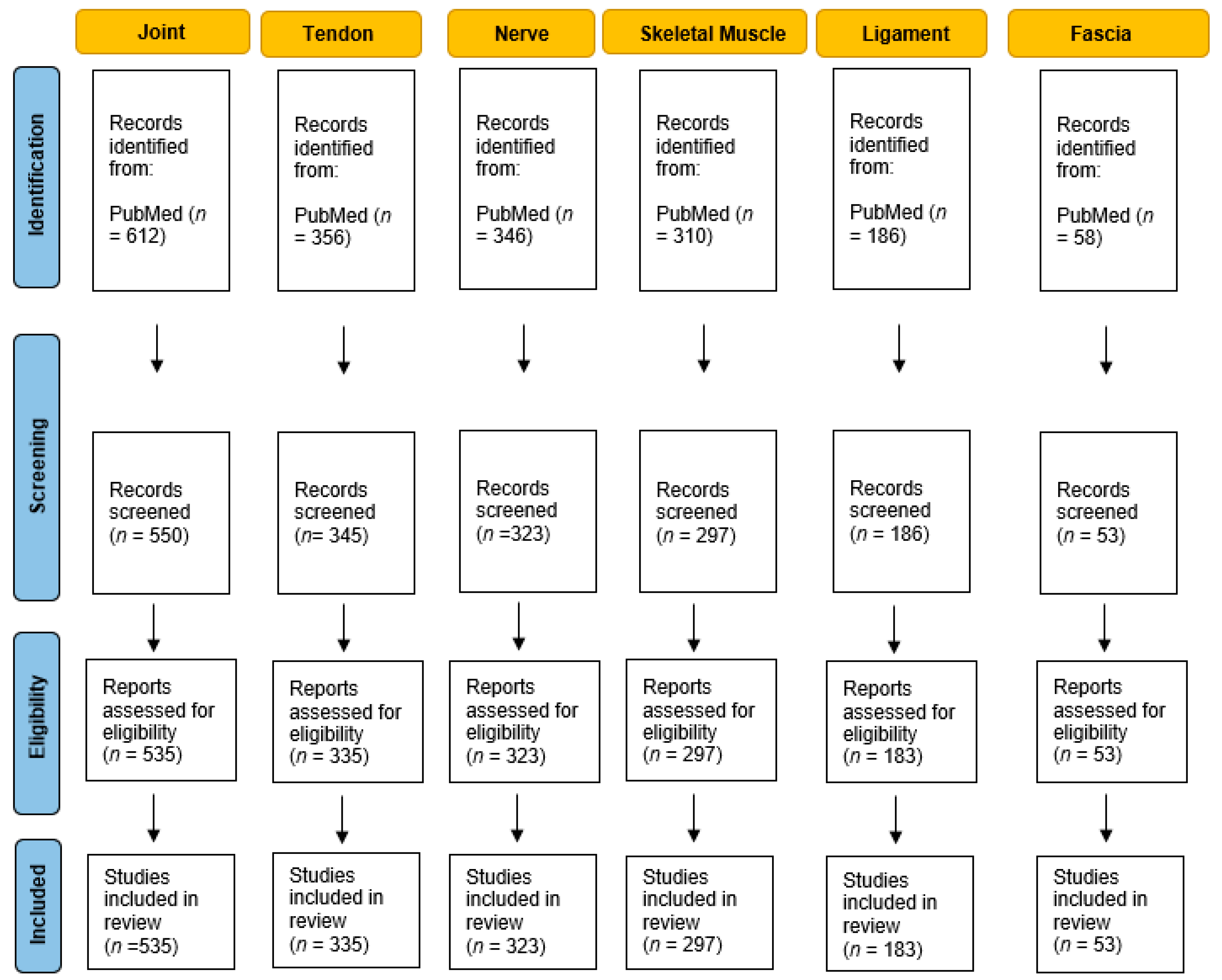
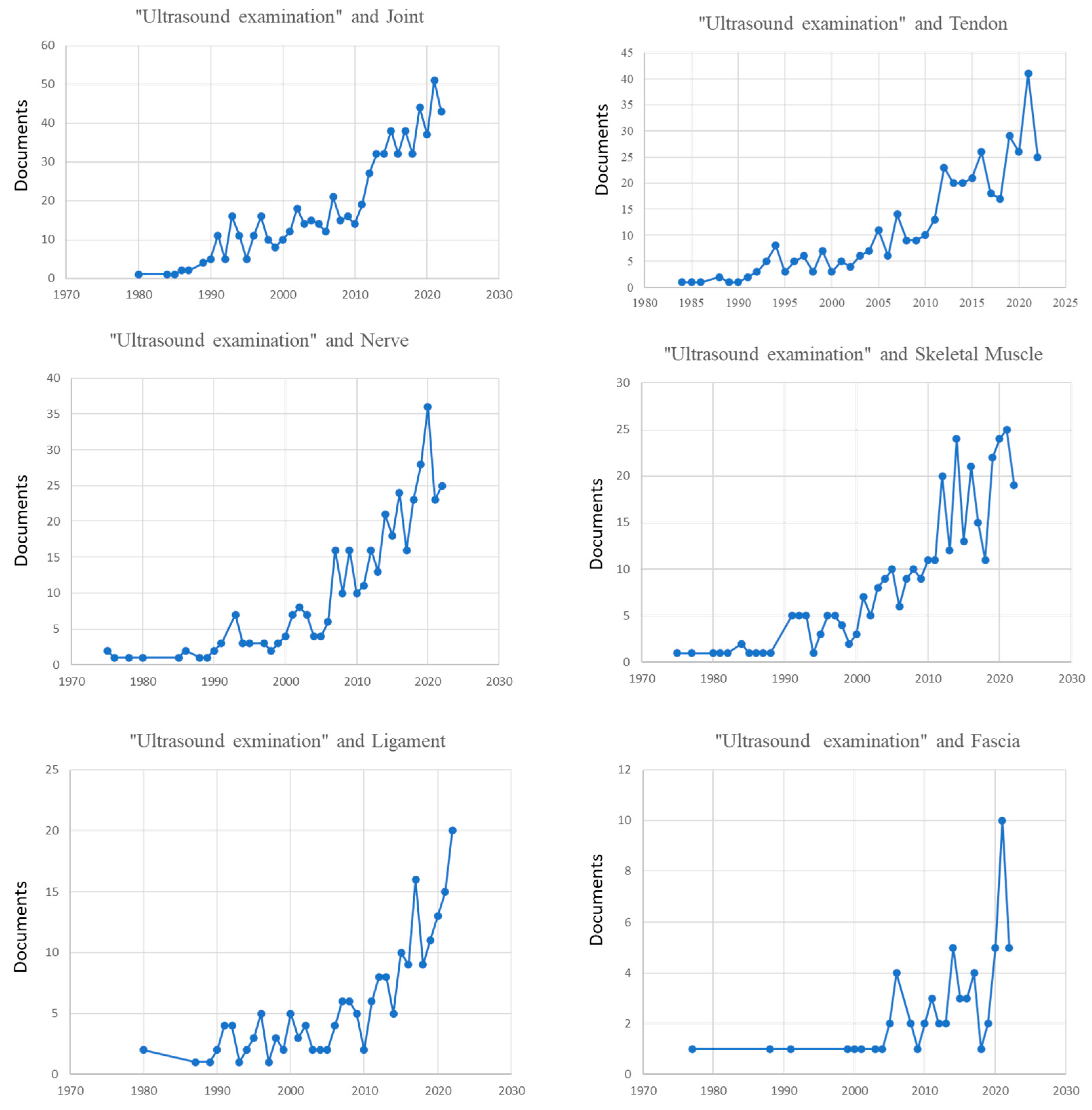
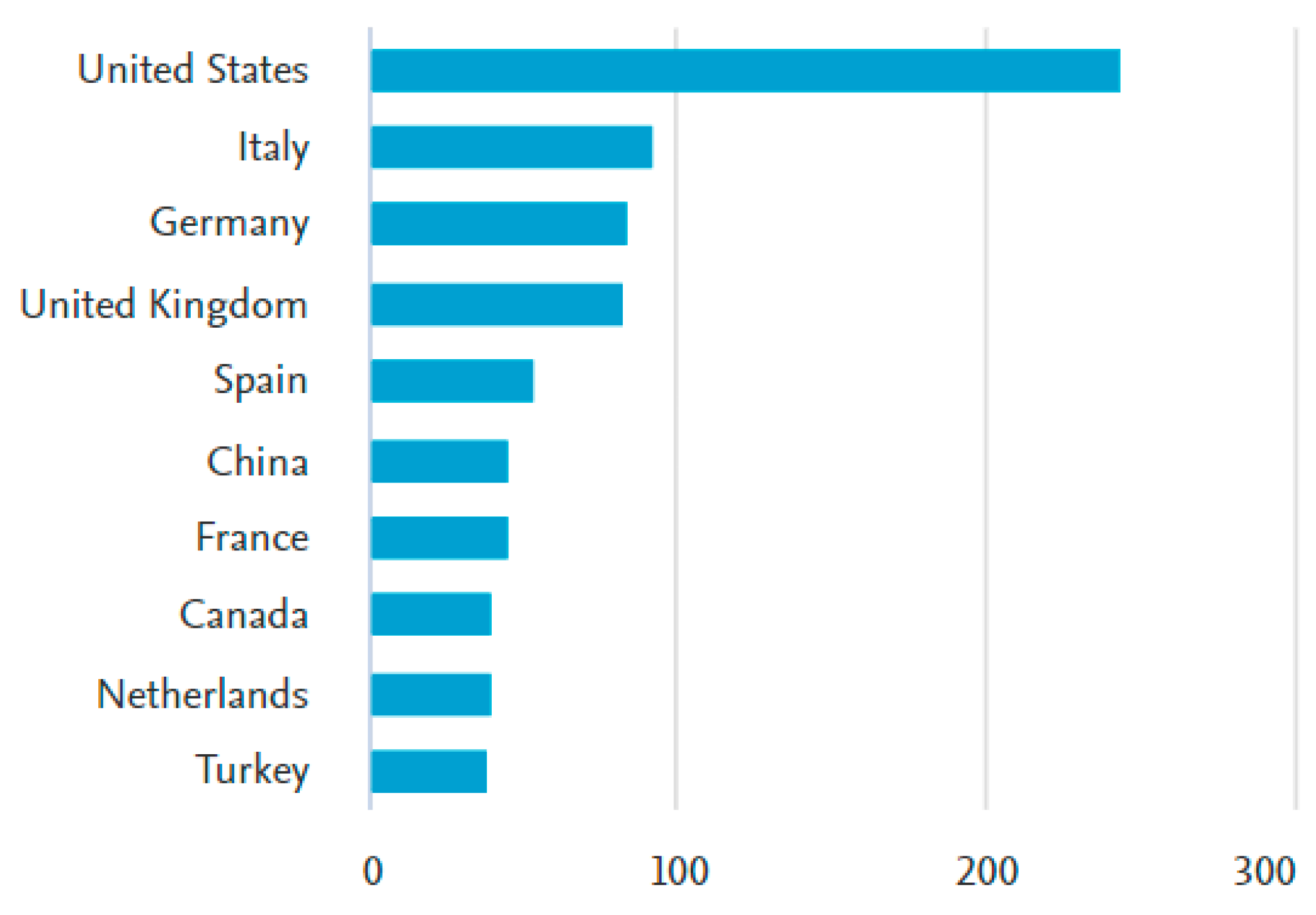
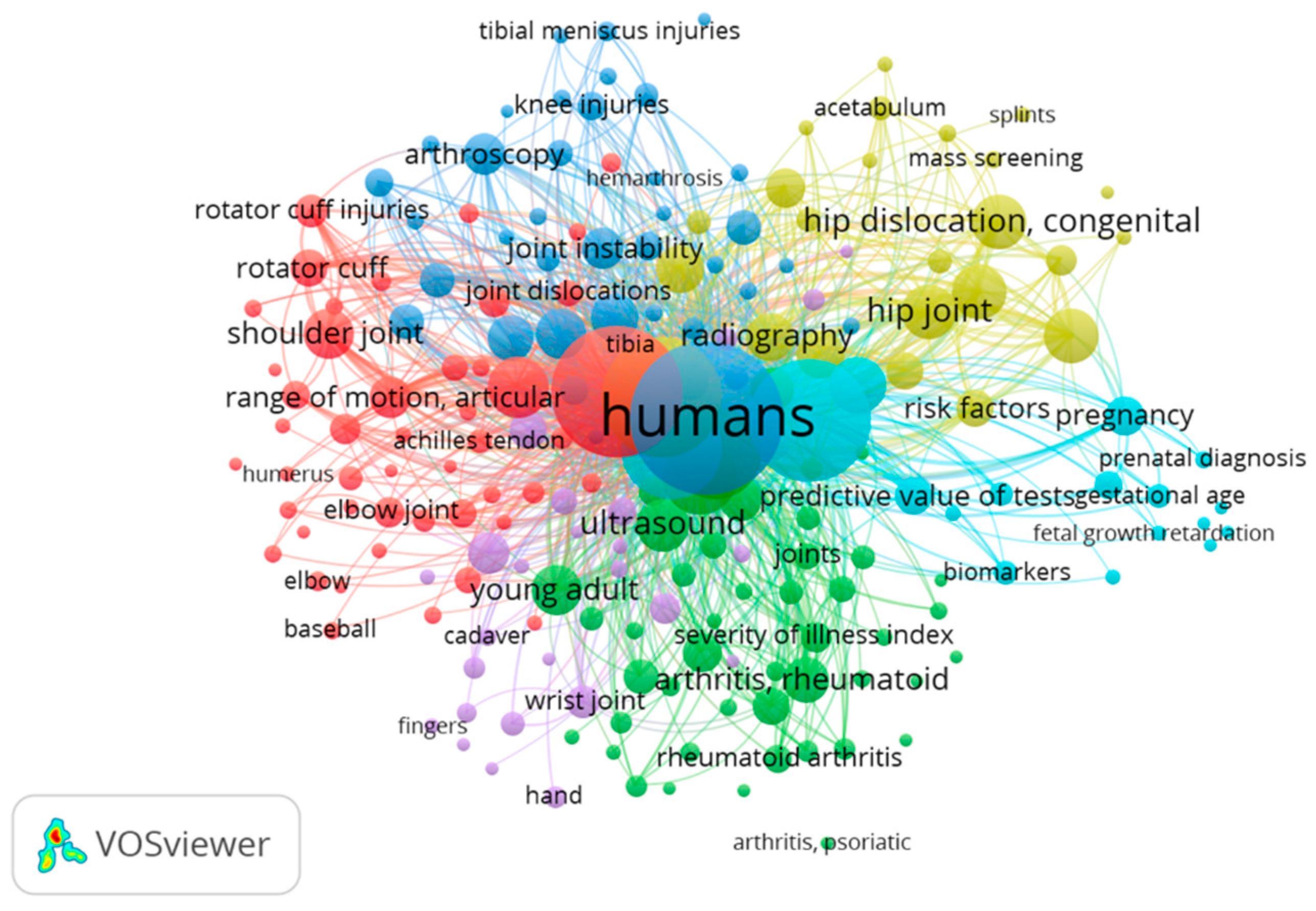
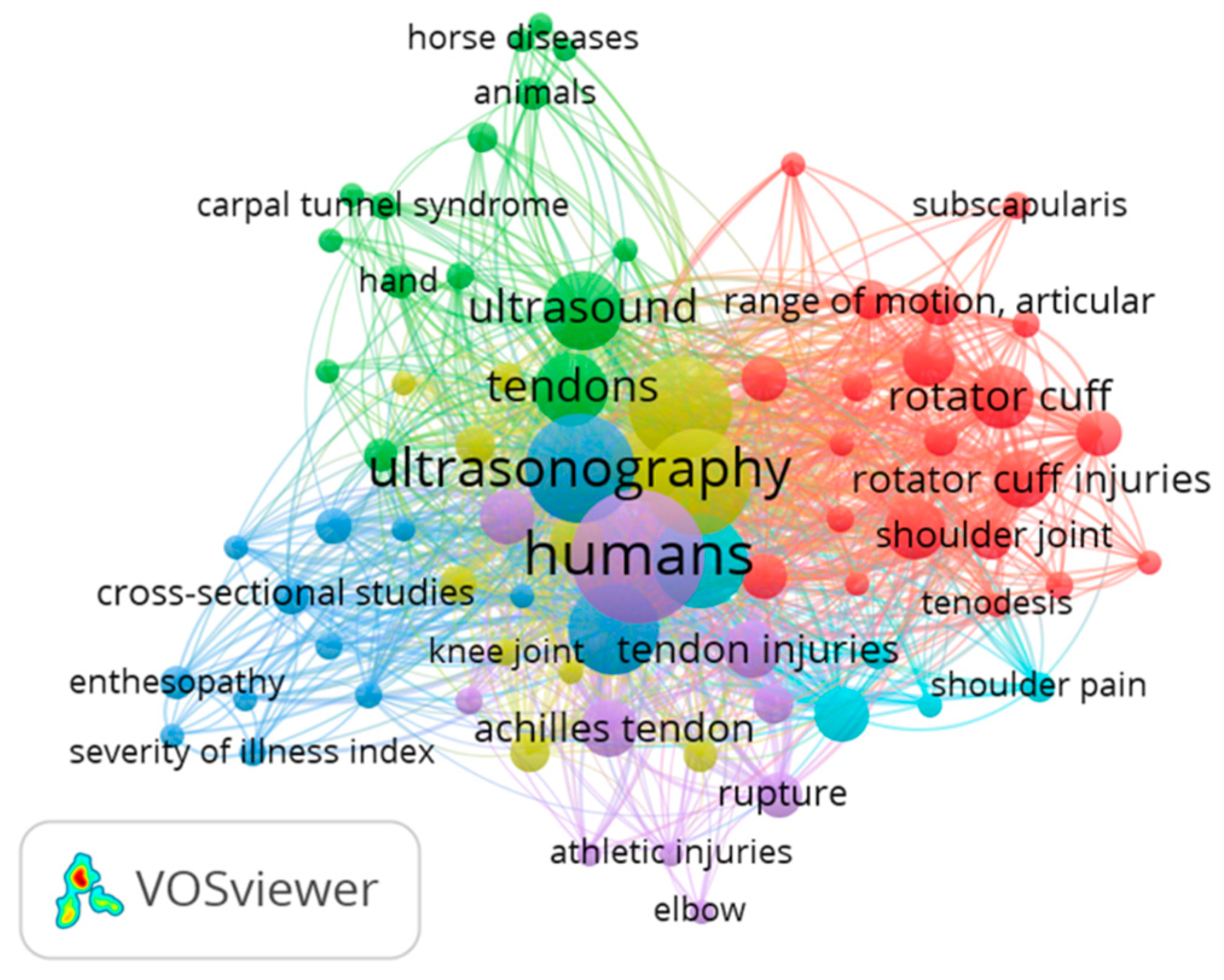
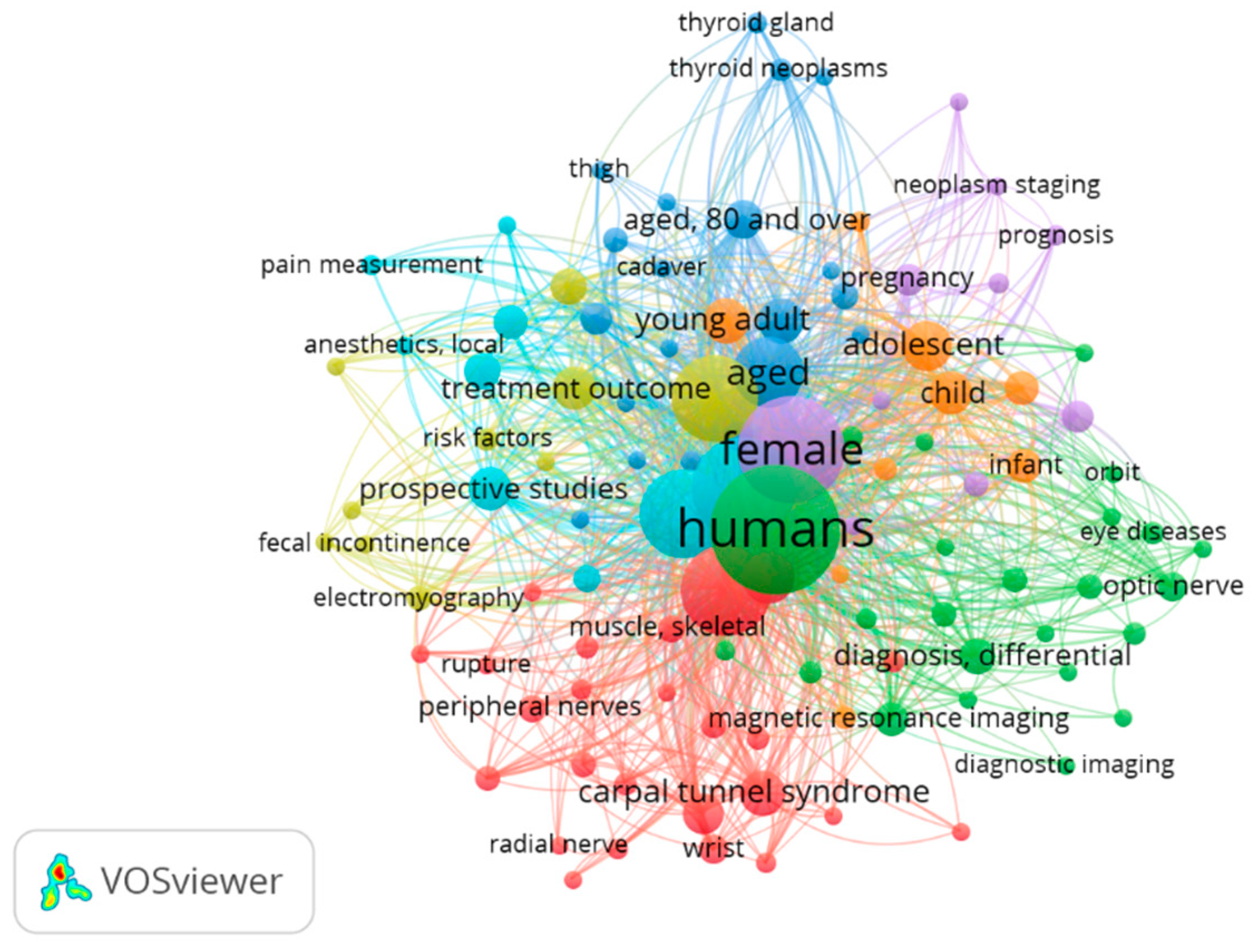


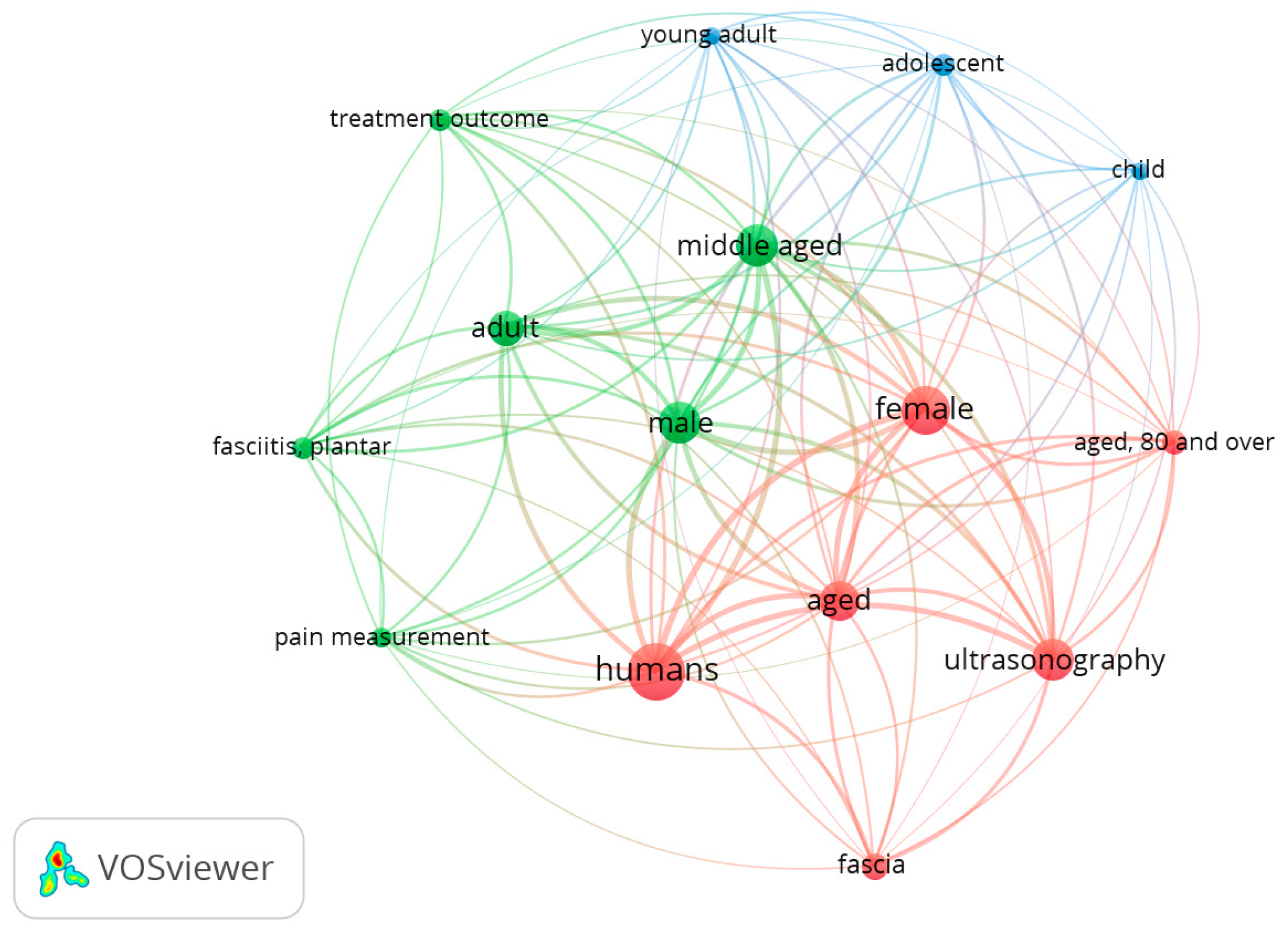
| Journals | Publications (N) |
|---|---|
| Journal of Ultrasound in Medicine | 26 |
| Ultrasound in Medicine and Biology | 23 |
| American Journal of Physical and Rehabilitation Medicine Clinical and Experimental Rheumatology | 21 18 |
| Annals of the Rheumatic Diseases | 14 |
| Arthritis Care and Research | 14 |
Disclaimer/Publisher’s Note: The statements, opinions and data contained in all publications are solely those of the individual author(s) and contributor(s) and not of MDPI and/or the editor(s). MDPI and/or the editor(s) disclaim responsibility for any injury to people or property resulting from any ideas, methods, instructions or products referred to in the content. |
© 2023 by the authors. Licensee MDPI, Basel, Switzerland. This article is an open access article distributed under the terms and conditions of the Creative Commons Attribution (CC BY) license (https://creativecommons.org/licenses/by/4.0/).
Share and Cite
Pirri, C.; Pirri, N.; Stecco, C.; Macchi, V.; Porzionato, A.; De Caro, R.; Özçakar, L. ‘Ultrasound Examination’ of the Musculoskeletal System: Bibliometric/Visualized Analyses on the Terminology (Change). Tomography 2023, 9, 352-361. https://doi.org/10.3390/tomography9010028
Pirri C, Pirri N, Stecco C, Macchi V, Porzionato A, De Caro R, Özçakar L. ‘Ultrasound Examination’ of the Musculoskeletal System: Bibliometric/Visualized Analyses on the Terminology (Change). Tomography. 2023; 9(1):352-361. https://doi.org/10.3390/tomography9010028
Chicago/Turabian StylePirri, Carmelo, Nina Pirri, Carla Stecco, Veronica Macchi, Andrea Porzionato, Raffaele De Caro, and Levent Özçakar. 2023. "‘Ultrasound Examination’ of the Musculoskeletal System: Bibliometric/Visualized Analyses on the Terminology (Change)" Tomography 9, no. 1: 352-361. https://doi.org/10.3390/tomography9010028
APA StylePirri, C., Pirri, N., Stecco, C., Macchi, V., Porzionato, A., De Caro, R., & Özçakar, L. (2023). ‘Ultrasound Examination’ of the Musculoskeletal System: Bibliometric/Visualized Analyses on the Terminology (Change). Tomography, 9(1), 352-361. https://doi.org/10.3390/tomography9010028











